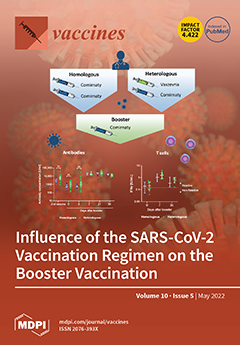Open AccessArticle
Safety and Immunogenicity of the BBIBP-CorV Vaccine in Adolescents Aged 12 to 17 Years in the Thai Population: An Immunobridging Study
by
Kriangkrai Tawinprai, Taweegrit Siripongboonsitti, Thachanun Porntharukchareon, Preeda Vanichsetakul, Saraiorn Thonginnetra, Krongkwan Niemsorn, Pathariya Promsena, Manunya Tandhansakul, Naruporn Kasemlawan, Natthanan Ruangkijpaisal, Narin Banomyong, Nanthida Phattraprayoon, Teerapat Ungtrakul, Kasiruck Wittayasak, Nawarat Thonwirak, Kamonwan Soonklang, Gaidganok Sornsamdang and Nithi Mahanonda
Cited by 4 | Viewed by 2417
Abstract
Adolescents can develop a severe form of Coronavirus disease 2019 (COVID-19), especially with underlying comorbidities. No study has examined the efficacy or effectiveness of inactivated COVID-19 vaccines in adolescents. This single-center, prospective cohort study was performed to evaluate the safety and effectiveness of
[...] Read more.
Adolescents can develop a severe form of Coronavirus disease 2019 (COVID-19), especially with underlying comorbidities. No study has examined the efficacy or effectiveness of inactivated COVID-19 vaccines in adolescents. This single-center, prospective cohort study was performed to evaluate the safety and effectiveness of an inactivated COVID-19 vaccine in adolescents using the immunobridging approach at Chulabhorn Hospital. The key eligibility criterion was a healthy clinical condition or stable pre-existing comorbidity. The anti-receptor-binding domain (anti-RBD) antibody concentration at 4 weeks after dose 2 of the vaccine was compared between participants aged 12 to 17 years and those aged 18 to 30 years. Safety profiles included adverse events within 7 days after each dose of the vaccine and any adverse events through 1 month after dose 2 of the vaccine. In the adolescent and adult cohorts, the geometric mean concentration of anti-RBD antibody was 102.9 binding antibody unit (BAU)/mL (95% CI, 91.0–116.4) and 36.9 BAU/mL (95% CI, 30.9–44.0), respectively. The geometric mean ratio of the adolescent cohort was 2.79 (95% CI, 2.25–3.46,
p < 0.0001) compared with the adult cohort, meeting the non-inferiority criterion. The reactogenicity was slightly lower in the adolescent than in the adult cohort. No serious adverse events occurred. The inactivated COVID-19 vaccine appears safe and effective in adolescents.
Full article
►▼
Show Figures






